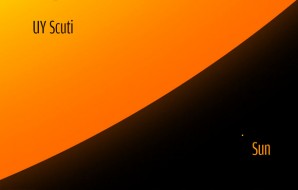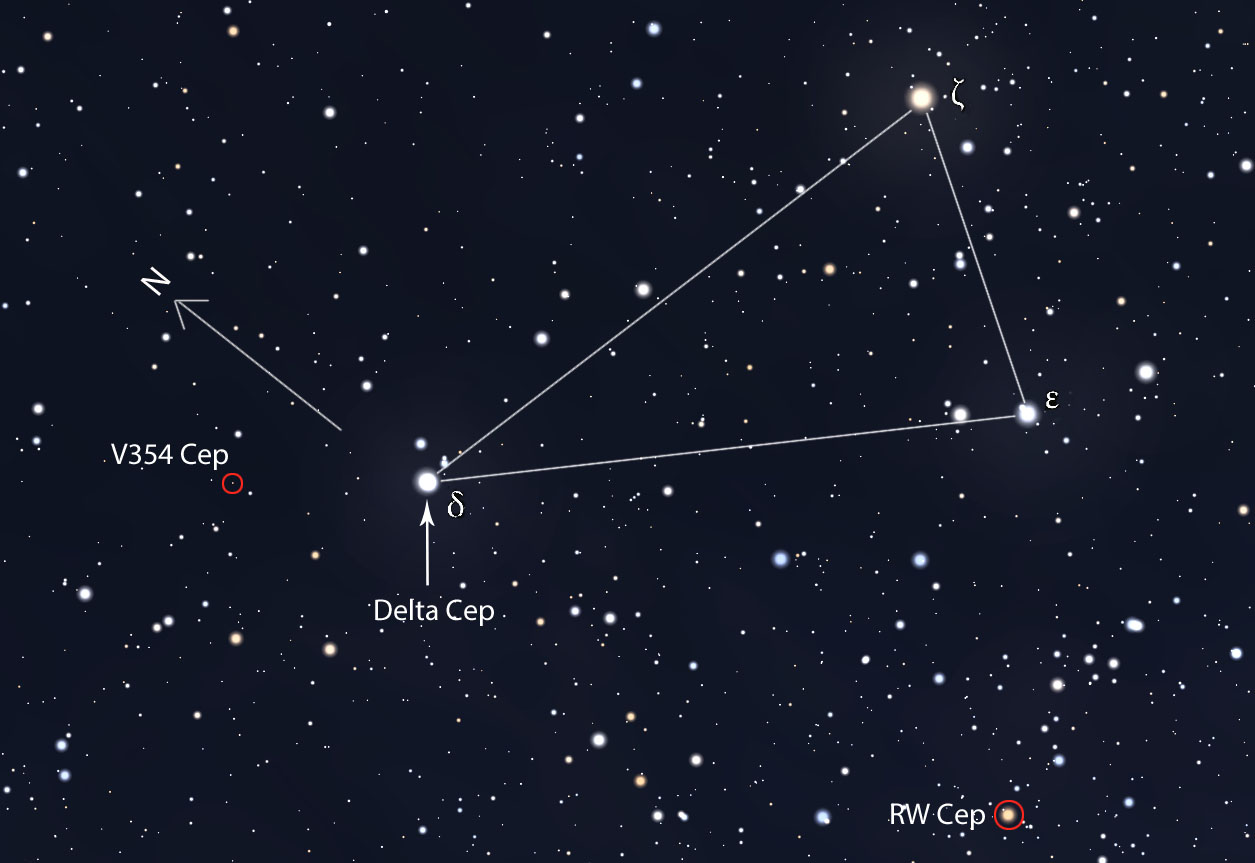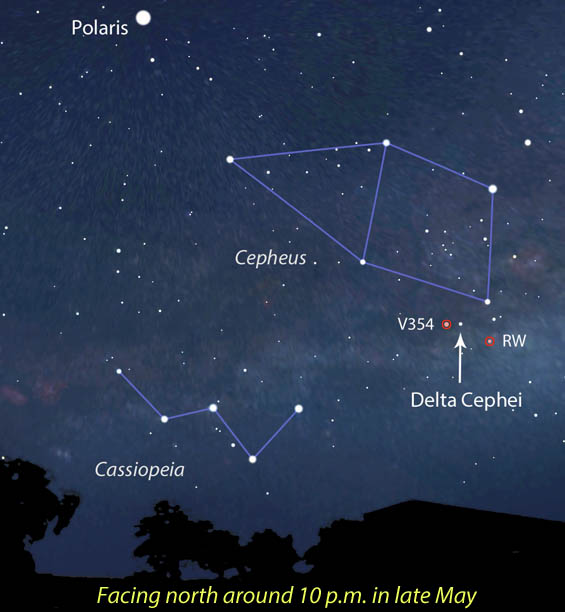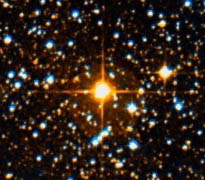There Be Monsters Here! How to Find the Biggest Star
Antares and Betelgeuse may be colossal stars, but we take it to the next level of stellar monstrosity with a visit to UY Scuti, a star that makes our Sun seem no bigger than a pinpoint.

This illustration shows the approximate size of the red supergiant UY Scuti compared to the Sun.
Philip Park / CC BY-SA 3.0
Philip Park / CC BY-SA 3.0
Stars range in size from red supergiants that if put in place of the Sun would reach beyond Saturn down to neutron stars that would fit comfortably within a limits of small city. Great examples of bright, well-known supergiants include Orion's Betelgeuse and Antares in Scorpius. The latter twinkles a fist to the lower left of Mars this week and shares its fiery color.
At ~1,000 times the size of the Sun, Betelgeuse is an impressive star to be sure, but it's no match for UY Scuti, currently the largest star known with a diameter around 3,400 times that of the Sun. It's a crazy-bright candle, too, with a luminosity 340,000 times greater than the Sun.
If you were to replace the Sun with UY Scuti, its photospheric fringes would extend beyond the orbit of Saturn halfway to Uranus, a distance of 1.4 billion miles (2.2 billion kilometers). A beam of light would take some 7 hours to circle the star's circumference compared to 14.5 seconds for the Sun.

A selection of stellar giants, ranging from the orange giant Aldebaran up to the current size-record holder UY Scuti.
Jcpag2012 / CC BY-SA 4.0
Jcpag2012 / CC BY-SA 4.0
You might think that such an enormous body would be easily visible with the naked eye, and it might be were it not 9,500 light-years away and squarely located in the Milky Way's Great Rift. After battling distance and dust, UY never gets brighter than magnitude +9 but can dip as low as +11.
Either way, it's still an easy catch in a 4-inch or larger telescope from reasonably dark skies. I observed it on May 22nd in a 10-inch reflector at 76× and can happily report the star hovers at the bright end of its range around magnitude +9.5. Even in full moonlight, I could detect its reddish hue.
Judging by its name, you've already guessed that UY Scuti's a variable star like so many of its supergiant brothers and sisters. Variations in the rate that the star burns helium, coupled with mass loss, cause it to undergo pulsations with a period of roughly 740 days.
UY Scuti's not difficult to find, located about 2° north of 5th-magnitude Gamma (γ) Scuti and 4° southwest of 4th-magnitude Alpha (α) Scuti just below the tail of Aquila. From the mid-United States, it climbs to 20° altitude by 11:30 p.m. local time in late May and 10:30 p.m. in mid-June.
While the map I've provided should get you right up to the star, you might also like to print out the AAVSO chart which shows the field in black-and-white reverse. Some observers find reverse maps easier to to use at the telescope.

This map, which shows stars to magnitude +10, plots the position of the luminous supergiant star UY Scuti, one of the largest stars known. Click to enlarge — pardon the pun!
Stellarium
Stellarium
If UY Scuti whets your appetite for more monster madness, spring and summer abound with lesser though still impressive naked-eye supergiants such as Antares (750× solar), Rho Cassiopeiae (450× solar) and Alpha Herculis a.k.a. Rasalgethi (400× solar and a beautiful double star to boot). Not as well known but nearly as large as UY are V354 Cephei (1,520× solar) and RW Cephei. RW currently occupies the #3 spot in the list of largest stars with a diameter of 1,535 solar or larger than Jupiter's orbit.

Supergiants RW Cep and V354 Cep are within a stone's throw of the famed variable, Delta Cephei, an easy naked-eye star. V354 lies 45′ northeast of Delta, while RW Cep is 2.5° south of the star. All three are circumpolar from many U.S., Canadia, and European locations.
Map: Bob King, Source: Stellarium
Map: Bob King, Source: Stellarium
Lucky for us, both V354 Cep and RW Cep lie close to one of the most famous variables of all, Delta Cephei. Center Delta in your low power eyepiece and you're halfway there. RW shines around magnitude +6.5, so you can easily spot this fiery orange spark in binoculars; V354 will prove a little more challenging at its current magnitude of +11.7. You'll find AAVSO charts to which I've labeled the brighter stars to make a bit more intuitive hereand here.

Use this wide-view locator map to point you toward RW Cep and V354 Cep, both of which sit close to Delta Cephei. The view is from latitude 40° N.
Map: Bob King, Source: Stellarium
Map: Bob King, Source: Stellarium
When describing stellar diameters, particularly the bloated red and yellow supergiants, determining a precise size is no easy task. Their atmospheres are so distended and vaporous, the diameters given in this article are best estimates and should be taken with a molecule of caution. Material lost through stellar winds creates shifting envelopes of gas and dust around each, making it tricky to say where star ends and winds begin.
Every one of these supergiants is a potential supernova candidate. Looking at them in the telescope, you can almost hear the sizzle of helium burning to carbon in their cores. As heat and pressure continue to forge new elements all the way up through iron, the stars will ultimately shut down, implode, and then explode as supernovae. Perhaps a tiny pulsar, a spinning neutron star the size of a city, will be left in the wake of the explosion. If so, in one fell swoop, the biggest stars will become the smallest.
https://linksredirect.com/?pub_id=11719CL10653&url=http%3A//www.airtel.in/


No comments:
Post a Comment